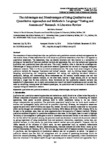The Advantages and Disadvantages of Using Qualitative and Quantitative Approaches and Methods in Language “Testing and Assessment” Research: A Literature Review
| dc.contributor.author | Rahman, MS | en |
| dc.date.accessioned | 2020-10-26T13:56:54Z | |
| dc.date.available | 2020-10-26T13:56:54Z | |
| dc.identifier.issn | 1927-5250 | en |
| dc.identifier.uri | http://hdl.handle.net/10026.1/16598 | |
| dc.description.abstract |
The researchers of various disciplines often use qualitative and quantitative research methods and approaches for their studies. Some of these researchers like to be known as qualitative researchers; others like to be regarded as quantitative researchers. The researchers, thus, are sharply polarised; and they involve in a competition of pointing out the benefits of their own preferred methods and approaches. But, both the methods and approaches (qualitative and quantitative) have pros and cons. This study, therefore, aims to discuss the advantages and disadvantages of using qualitative and quantitative research approaches and methods in language testing and assessment research. There is a focus on ethical considerations too. The study found some strengths of using qualitative methods for language “assessment and testing” research—such as, eliciting deeper insights into designing, administering, and interpreting assessment and testing; and exploring test-takers’ behaviour, perceptions, feelings, and understanding. Some weaknesses are, for instance, smaller sample size and time consuming. Quantitative research methods, on the other hand, involve a larger sample, and do not require relatively a longer time for data collection. Some limitations are that quantitative research methods take snapshots of a phenomenon: not in-depth, and overlook test-takers’ and testers’ experiences as well as what they mean by something. Among these two research paradigms, the quantitative one is dominant in the context of language testing and assessment research. | en |
| dc.format.extent | 102 - 102 | en |
| dc.language.iso | en | en |
| dc.publisher | Canadian Center of Science and Education | en |
| dc.title | The Advantages and Disadvantages of Using Qualitative and Quantitative Approaches and Methods in Language “Testing and Assessment” Research: A Literature Review | en |
| dc.type | Journal Article | |
| plymouth.issue | 1 | en |
| plymouth.volume | 6 | en |
| plymouth.publication-status | Published online | en |
| plymouth.journal | Journal of Education and Learning | en |
| dc.identifier.doi | 10.5539/jel.v6n1p102 | en |
| plymouth.organisational-group | /Plymouth | |
| plymouth.organisational-group | /Plymouth/Faculty of Science and Engineering | |
| plymouth.organisational-group | /Plymouth/Users by role | |
| plymouth.organisational-group | /Plymouth/Users by role/Academics | |
| dc.identifier.eissn | 1927-5269 | en |
| dc.rights.embargoperiod | Not known | en |
| rioxxterms.versionofrecord | 10.5539/jel.v6n1p102 | en |
| rioxxterms.licenseref.uri | http://www.rioxx.net/licenses/all-rights-reserved | en |
| rioxxterms.type | Journal Article/Review | en |


